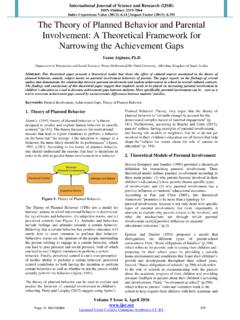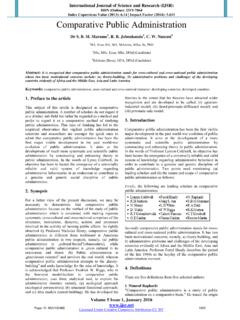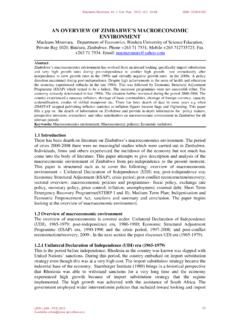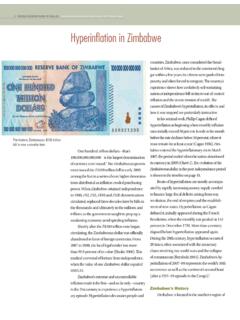Transcription of The Challenges of Recruitment and Selection of Employees ...
1 International Journal of Science and Research (IJSR) ISSN (Online): 2319-7064 Volume 3 Issue 1, January 2014 Challenges of Recruitment and Selection of Employees in zimbabwean Companies Alice Z Zinyemba University of Zimbabwe, Business Studies Department, B006, Rollo Drive, Mt. Pleasant, Zimbabwe Abstract: Recruitment and Selection of staff in Zimbabwe comes with Challenges that the human resources manager must grapple with. This paper presents findings from a research carried out in 10 companies in Zimbabwe on the Challenges that they face withrecruitment and Selection of staff. Identified Challenges include brain drain, high labour turnover, scarcity of skills and expertise in the labour market, and unemployment. Other Challenges include costs associated with Recruitment .
2 Smaller companies compete with biggercompanies which can better absorb the costs associated with Recruitment and are also capable of paying better salaries. Lack of human resources planning, geographical location of jobs and use of information technology in advertising are other Challenges that employerorganizations face when recruiting and selecting Employees . These Challenges have led to a lack of transparency in the Recruitment process, untrustworthiness of Employees , and favouritism involved with both external Recruitment and internal promotions. Bettermanagement of the Recruitment and Selection process assists the organization in making realistic decisions about a prospective candidate. Better management implies proper human resource planning and writing accurate job descriptions to ensure that precedence is given to the competencies necessary for the achievement of the company s objectives.
3 Keywords: Recruitment , Selection , Challenges , human resources management, brain drain The word Recruitment has been defined by different authors in different ways but all meaning the same thing. All the definitions seem to agree that Recruitment is a process of actively seeking potential candidates in sufficient numbers and qualities to fill vacant positions within organization [6], [7]. It is a process of attracting job applications from those interested. It is that activity which generates a pool of applicants who have the desire to be employed by an organization from which those found suitable can be Morrell [5] argues, Recruitment should be regarded as the first step in filling in a vacancy. Ideally, Recruitment should be taken as a proactive process of ensuring that the organization has the requisite skills and experience which cannot be easily built from within but sourced from outside the organization.
4 Selection is understood to refer to the process of choosing or selecting the right candidate from a pool of potential candidates who have applied for a job. In short, Recruitment refers to attracting job applications from interested people. Selection refers to the process of identifying the most suitable candidate from a pool of applicants. The zimbabwean crisis in the new millennium has brought with it economic Challenges resulting in high levels of unemployment and poverty. The Recruitment and Selection practice in zimbabwean companies is fraught with Challenges that should be properly managed to ensure the achievement of company objectives. 2. Background to the Study In response to the economic Challenges that Zimbabwe was facing in the late 80s and early 90s, the World Bank did not extend an export revolving fund until the country had liberalised its trade policy [9].
5 This resulted in Zimbabwe adopting a World Bank Economic Structural Adjustment Programme (ESAP) in 1991. Measures taken by government in implementing ESAP include the following: A rapid devaluation of the Zimbabwe dollar and introduction of a floating exchange rate; Eliminating controls on prices and wages; Liberalization of trade and investment; Reducing the civil service and state spending Ending subsidies Commercialisation of many government-owned businesses [3]. In spite of these efforts, the economic situation worsened. Poverty levels increased from 26% in 1990 to 55% in 1995 [3]. Successive years of drought impacted negatively on the land reform programme and made the people poorer. One of the most pressing health problems for Zimbabwe is the HIV/AIDS pandemic which has had negative impact and worsened the economic situation.
6 It was estimated that one in every four adults was infected by the HIV virus in 2003 while it was estimated that by the end of 2007, million people were living with HIV and AIDS. It is estimated that 140 000 people died from HIV/AIDS during 2007 [3]. In recent years, the HIV/AIDS prevalence in Zimbabwe has been declining from 18% in 2005 - 6 to 15 % in 2012 [8]. The HIV/AIDS pandemic resulted in deaths of working age people and early retirement from work due to illness. Poor economic performance, successive years of drought all contributed to hyperinflation and the resultant corruption. By the end of 2008 the USD was equivalent to ZD with 21 zeros. In mid 2007 the parallel exchange rate was 1 000 times the official rate.
7 This situation is often referred to as the Zimbabwe crisis . The Zimbabwe crisis saw many people migrating to live and work in neighbouring countries especially in Botswana and South Africa. In the formal sector the average monthly wage ranged from USD 150 to USD 300 [3]. The high levels of poverty and unemployment saw a lot of professionals migrating to Europe, America, Canada, Australia and New Zealand, among other countries, in search of greener pastures. Paper ID: 0201365229 International Journal of Science and Research (IJSR) ISSN (Online): 2319-7064 Volume 3 Issue 1, January 2014 Purpose of the Study The purpose of the study was to identify the Challenges of Recruitment and Selection that employers in Zimbabwe face and what can be done to management those Challenges .
8 This paper presents findings of the study based on a qualitative research carried out in 10 organizations in Zimbabwe. 4. Research MethodologyInterviews were held with a random Selection of human resources managers from 10 organizations whose head offices are located in Harare, the capital city of Zimbabwe. The 10 randomly selected organizations included two (2) commercial banks, three (3) manufacturing companies, two (2) government ministries and three (3) retail companies. The key questions asked were: What were the Challenges associated with Recruitment and Selection that employers faced? were the Challenges associated with Recruitment and Selection that prospective Employees faced? can these Challenges be managed or mitigated?
9 The study was targeted at Human resources practitioners in both the private and public sectors in Harare. 5. Importance of the StudyThe study is important in that it identifies the Challenges that manager s face in trying to recruit and select the right candidate for a job. The study also high lights those Challenges that prospective Employees face when they are applying for jobs. Suggestions on how the Challenges of Recruitment and Selection of staff in Zimbabwe can be abated are provided in the study. The purpose of this paper is to present the findings from the study which was carried out in the first half of 2013. The research was based on a random Selection of ten human resources practitioners from ten organizations consisting of three retail companies, two manufacturing companies, three commercial banks and two hospitality companies.
10 The respondents were all from the capital city where head offices of most companies are located. The sample is not representative of the private and public organizations in Zimbabwe. It is indicative of the Challenges facing employers and Employees in general. 6. Research Findings Cost of advertising Advertising is done in order to have a greater pool of applicants from which to select. It is company policy in many organizations to advertise for vacant posts. Advertising in print media such as newspapers and journals and on television is expensive. The study established that most companies in Zimbabwe use print media for advertising job vacancies. Other than the cost, there is a another challenge associated with advertising, that of determining which is the best print media or television programme with a wider readership or listenership in which to advertise.

















